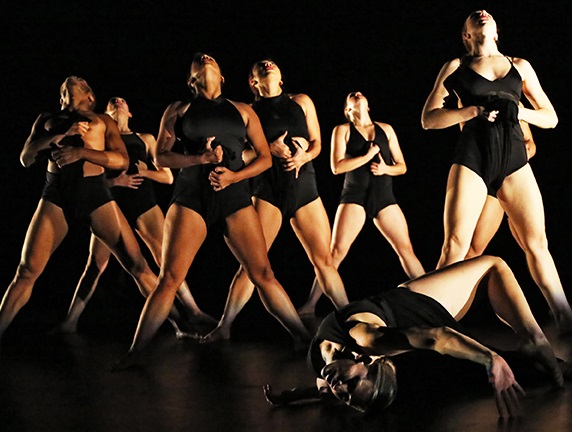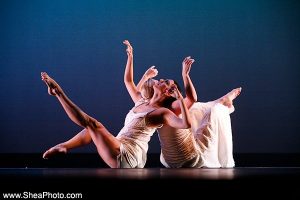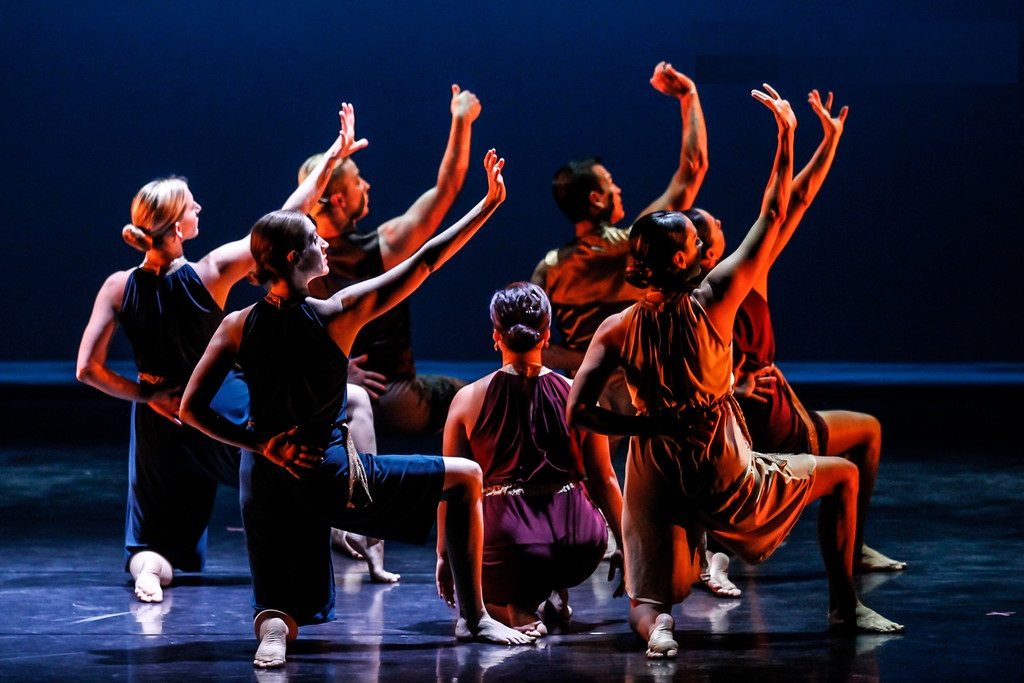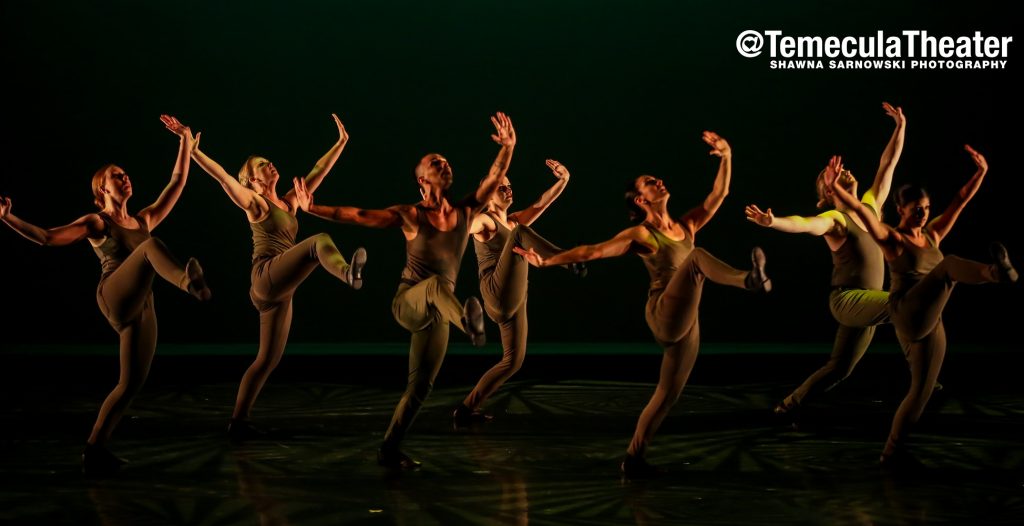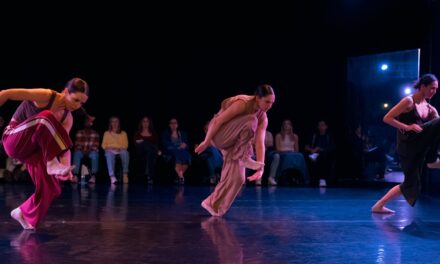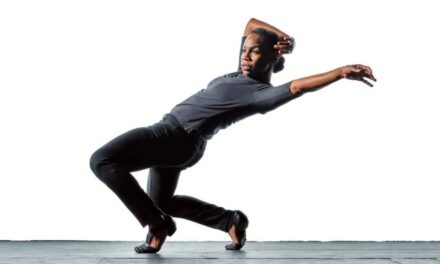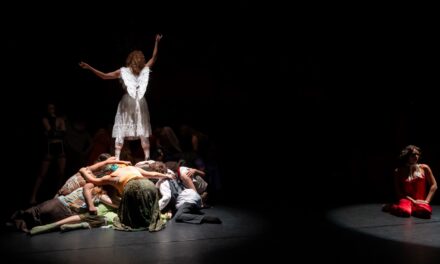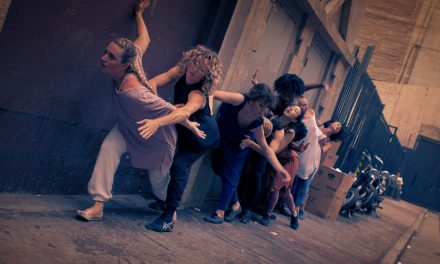Nannette Brodie has managed to keep her company, the Nannette Brodie Dance Company, moving forward since her first concert in 1986. The company presented its 30th anniversary concert, Passion & Grace, this past weekend at the Martha B. Knoebel Dance Theater. This intimate dance theater with a large stage is part of the Dance Center, at the California State University, Long Beach. The oldest work on the program Holiday, was choreographed and performed by Brodie and Danial Shapiro in 1978 and re-staged for Brodie’s company in 2009. The newest work was the premiere of Every Soldier Has A Story, which included choreography by Brodie and Company, Stephanie Maxim and Erica Villalpando.
Before she spoke to the audience, Brodie performed a lovely, loving and nostalgic solo, reminding me of the beautiful dancer I first saw perform back in the late 1970s. The movement was lyrical and laced with warm and welcoming humor, allowing the audience to enter her creative world.
It was clear that Brodie wanted to present an overview of her 30 years of work, but the program was uneven and long, approximately 2 hours, not counting the 20 minutes late start with no reason for the delay announced. There were strong works like Let Them Eat Cake, Seeing Through, Strength In Sorrow and Every Soldier Has A Story in the first two acts, while others, like those in the final act, perhaps should not have been included. Holiday lacked the talent and presence of its original cast, Brodie and Shapiro. It also suffered from very clumsy partnering by Ismael Murillo. Excerpt from Night Blooms was simply too short to tell where the dance was going, and Vientos De Andalucia, which looked to be interesting and was performed very well, suffered because it arrived at the end of long evening.
Let Them Eat Cake was choreographed in 2013 by Nannette Brodie and Company. The costumes by Elias Roldan were vibrant and fancifully reflected the 18th Century French aristocracy. The work was joyful and appeared to be fun to perform. Playful duets occurred throughout with beautifully structured group sections. One could imagine these characters romping about while the peasants starved during Maria Antoinette’s reign. It was an energetic and friendly opener to the program, performed well by Priya Chisti, Dennzyl Green, Amy Kuo, Rebecca Martin, Megan McLean, Nathan Ortiz, Matthew Reiner, Jana Taylor, and Erica Villalpando. The lively music was by Japanese composer Takenobu.
Seeing Through was an intriguing work, choreographed by Brodie, Cristina D’Agostino, and Stephanie Maxim in 2013. Performed here by Maxim and Teresa Rios, the two women began atop a high gymnastic bar with soft, paddling leg movements resembling those made by swimmers seated at the edge of a lake or pool. They were separated from the front of the stage by a scrim that created a dreamlike atmosphere. Throughout the work, Maxim and Rios mirrored each other’s movement, supported one another and interlocked elbows and knees. I was left with the sense that this was one being or two creatures whose existence was completely dependent on their proximity.
The set for Seeing Through designed by Brodie and Brock Cilley, costumes by Diane Browne and the somewhat somber music was composed by Aubrey Halford and Kerry Muzzey.
I have never been a fan of multiple black outs in a dance, and in Seen and Unseen, Brodie came very close to losing my attention. Choreographed by Brodie and Company in 2009 as part of the Dark to Light dance series, three men moved in, through and around pools of light that were interspersed with total darkness. I came away with a sense of internal struggle and/or pain, as well as a strong image of refugees fleeing persecution. The pools of light acted as search lights as well as revealing moments of hidden agonies and lives of people who feel invisible. The final scene with only the pools of light flashing randomly across the stage, gave power to the work’s theme of what we can see and the larger aspects of what we do not.
Timing was essential in Seen and Unseen, and sometimes the dancers weakened the piece because of their hesitation or lack of attention. Those dancers in were Dennzyl Green, Ismael Murillo and Nathan Ortiz. The music was composed by Ethel, David Lang.
One of the strongest works on the program was a dance titled Strength In Sorrow, choreographed for the company by Stephanie Maxim in 2017. Maxim dedicated the performance to her mother, and it was clear that this work was inspired by the several stages of grief. The music by Vivaldi, the gorgeous costumes by Maxim and strong performances by the dancers, culminated in a very powerful experience.
Strength In Sorrow is beautifully made and the choreographer’s usage of the half skirts added excitement and force to her statements. Maxim appears as the main character and she gave a commanding performance. The only element that weakens this work is the final crossing with Maxim draped ghost-like in the long panel of white cloth seen at the beginning hanging from above to the stage. She clearly states that this person has moved on and the cloth leaned too strongly toward the Hollywood version of a person’s spirit moving on.
Brodie and Company worked for two years on a project focusing on military veterans and their families. They taught movement classes at several military facilities around the area, including the Long Beach VA Hospital. During this time Brodie interviewed several of the veterans and from that she and the company created Every Soldier Has A Story. This was an insightful and poignant work that needs time to gel, mature and for edits (including the music transitions) to be implemented. A few of those veterans, including Brodie’s husband John, were in attendance and were thanked for their service by Brodie and the audience. It was a touching moment.
Divided into several sections, the work opened with Boogie Woogie Bugle Boy choreographed by Erica Villalpando, assisted by Nathan Ortiz, and performed with great energy and precision given that they were young students, by members of Woodrow Wilson High School’s Dance Ensemble. The song was written by Don Raye and Hughie Prince for the Andrew Sisters, which went on to become an iconic song from World War II.
Every Soldier Has A Story depicts the life of military service men and women from taking the oath of allegiance to the all too often drastic physical and emotional traumas war inflicts on veterans and their families. Brodie shows inductees lined up during their long and paperwork filled processing procedure which reminded me of the old saying I heard regarding life in the Army, “Hurry up and wait!”
In Drill the dancers took us through boot camp and the daily repetition of marches and exercises. We saw the horrors of combat in Conflict and veterans suffering from PTSD, nightmares and drug addiction during Reflection.
There were videos that appeared periodically of veterans in boot camp and in combat. We also heard a recorded heart-wrenching story of a veteran’s who related what he left behind each time he was employed to the Middle East, and there was a video of one black man, Charles Henry, who, while serving his country through World War II and the Korean War, had to endure the humiliations of prejudice and Jim Crow. Every Soldier Has A Story was not only a tribute to our nation’s veterans, it vividly depicted what they sacrifice to protect our fragile democracy.
The Woodrow Wilson High School’s Dance Ensemble members were Qory Moscoso, Axel Carvajal, Norma Garcia-Elizondo, Kaylee Brubaker, Soleil Gonzalez, Olivia Ferguson, London Perelli, Madelyn Thaxton, Olivia Ferguson, Jade Occasion, Marti Logan, Juana Gutierrez-Lopez, and Paola Perez. The Nannette Brodie Dance Theatre dancers were Bradford Chen, Priya Chisti, Julisa Figueroa, Dennzyl Green, Amy Kuo, Rebecca Martin, Stephanie Maxim, Megan McLean, Nathan Ortiz, Matthew Reiner, Jennie Sustaita, Jana Taylor, and Erica Villalpando.
The beautiful lighting design throughout the concert was by Johannah Caley; Sound Design was by Trenton Brodie; the Videographer was Jeff Hendrix; and the Photographers were Liz Thompson and Steve Shea.
For more information on the Nannette Brodie Dance Theatre, click here.
Feature photo: Nannette Brodie Dance Theatre – Strength In Sorrow by Stephanie Maxim – Photo: Shawna Sarnowski

